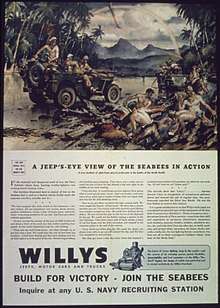Willys MB
The Willys MB and the Ford GPW, both formally called the U.S. Army Truck, 1⁄4-ton, 4×4, Command Reconnaissance,[2][3] commonly known as Jeep or jeep,[4] and sometimes referred to as G503,[nb 4] were highly successful off-road capable, light, military utility vehicles, built in large numbers to a standardized design, from 1941 to 1945, for the Allied forces in World War II.
| Willys MB Ford GPW | |
|---|---|
| Type | 1⁄4 ton[nb 2] 4×4 utility truck |
| Place of origin | United States |
| Service history | |
| In service | 1941 until varying per country |
| Wars | World War II Korean War Various post 1945 conflicts |
| Production history | |
| Designer | Karl Probst, Delmar G. Roos |
| Manufacturer |
|
| Produced | 1940–1945 |
| No. built |
|
| Variants | Ford GPA "Seep": 12,778 |
| Specifications (MB and GPW same[1]) | |
| Mass | 2,453 lb (1,113 kg) curb weight (includes engine fluids and full fuel) 2,337 lb (1,060 kg) dry weight |
| Length | 132 1⁄4 in (3.36 m) |
| Width | 62 in (1.57 m) |
| Height | overall, top up: 69 3⁄4 in (1.77 m) reducible to 52 in (1.32 m) |
| Engine | 134 cu in (2.2 l) Inline 4 Willys L134 "Go Devil" 60 hp (45 kW; 61 PS) |
| Power/weight | 49 hp/ST (54.0 hp/t) |
| Payload capacity | 800 lb (360 kg) |
| Transmission | 3 speed x 2 range transfer case |
| Suspension | Live axles on leaf springs front and rear |
| Ground clearance | 8 3⁄4 in (22 cm) |
| Fuel capacity | 15 US gal (12.5 imp gal; 56.8 L) |
Operational range | 300 mi (482.8 km) |
| Maximum speed | 65 mph (105 km/h) [nb 3] |
The jeep became the primary light wheeled transport vehicle of the United States Military and its Allies in World War II, as well as the postwar period, with President Eisenhower once calling it, "one of three decisive weapons the U.S. had during WWII." [5] It was also the world's first mass-produced four-wheel drive car, manufactured in six-figure numbers. About 650,000 units were built, constituting a quarter of the total U.S. non-combat motor vehicles produced during the war,[8] and almost two-thirds of the 988,000 light vehicle class produced, together with the Dodge WC series. Large numbers of jeeps were provided to the U.S.' allies, including Russia at the time — aside from large amounts of 11⁄2- and 21⁄2-ton trucks, some 50,000 jeeps and 25,000 3⁄4-tons were provided to Russia during WWII — more than Nazi Germany's combined total production of their Volkswagen vehicles, the Kübelwagen and the Schwimmwagen.[9]
Author Charles K. Hyde wrote: "In many respects, the jeep became the iconic vehicle of World War II, with an almost mythological reputation of toughness, durability, and versatility." [6] Not only did it become the workhorse of the American military, as it replaced the use of horses and other draft animals (still heavily used in World War I) in every role, from cavalry units to supply trains, but improvised field modifications also made the jeep capable of just about any other function GIs could think of.[10]
The jeep was considered such a valuable vehicle that General Eisenhower wrote that most senior officers regarded it as one of the five most important pieces of equipment used to win the war.[nb 5] Moreover, General George Marshall called the squared-off little car "America's greatest contribution to modern warfare." [12][13][14] In 1991, the MB Jeep was designated an "International Historic Mechanical Engineering Landmark" by the American Society of Mechanical Engineers.[15]
After WWII, the original jeep continued to serve, in the Korean War and other conflicts, until it was updated in the form of the M38 Willys MC and M38A1 Willys MD (in 1949 and 1952 respectively), and received a complete redesign by Ford in the form of the 1960-introduced M151 jeep. Its influence, however, was much greater than that—manufacturers around the world began building jeeps and similar designs, either under license or not—at first primarily for military purposes, but later also for the civilian market. Willys trademarked the "Jeep" name, turned the MB into the civilian Jeep CJ models, and Jeep became its own brand. The 1945 Willys Jeep was the world's first mass-produced civilian four-wheel drive car.
The success of the jeep inspired both an entire category of recreational 4WDs and SUVs, making "four-wheel drive" a household term, and numerous incarnations of military light utility vehicles. In 2010, the American Enterprise Institute called the jeep "one of the most influential designs in automotive history". Its "sardine tin on wheels" silhouette and slotted grille are perhaps even more instantly recognizable than the VW Beetle and has evolved into the currently produced Jeep Wrangler long after the demise of the original Volkswagen design. [14]
History

The design of the World War II jeep was the result of a long process, involving the contributions of both U.S. military officers and civilian engineers. The idea of the jeep originated with the infantry, which needed a low, powerful vehicle with four-wheel drive — the latter were mostly tied to three companies: Bantam, Willys and Ford, and the development has repeatedly been called a "design by committee".[16][17][18] In fall 1941, Lt. E.P. Hogan of the U.S. Quartermaster Corps wrote: "Credit for the original design of the Army's truck 1⁄4-ton, 4×4, may not be claimed by any single individual or manufacturer. This vehicle is the result of much research and many tests." [19] Hogan credited both military and civilian engineers, especially those working at the Holabird Quartermaster Depot.
Pre-war tests and conceptualization

Advances in early-20th century technology resulted in widespread mechanisation of the military during World War I. The United States Army deployed thousands of motor vehicles in that war, including some 12,800 Dodges,[21] and thousands of four-wheel drive trucks: Jeffery / Nash Quads, and trucks from the Four Wheel Drive Auto Company (FWD). General John Pershing viewed horses and mules as acceptable for the previous three U.S. wars, but in the new century, his cavalry forces had to move quicker, with more range and more personnel.[22]
Immediately after World War I, the use of motor vehicles in that war was considered only a prelude to much greater application in future armed conflicts. As early as 1919, the US Quartermaster Corps recommended the acquisition of a new kind of military vehicle, ".. of light weight and compact size, with a low silhouette and high ground clearance, and possess the ability to carry weapons and men over all sorts of rough terrain." [23] The U.S. Army started looking for a small vehicle suited for reconnaissance and messaging, while at the same time searching for a light cross-country weapons carrier.[24]
At the same time, there was a drive for standardization. By the end of World War I, U.S. forces overseas had a total of 216 makes and models of motor vehicles to operate, both foreign and domestic, and no good supply system to keep them running.[19]
Various light motor vehicles were tested--at first motorcycles with and without sidecars, and some modified Ford Model Ts.[25][26] In the early-1930s, the U.S. Army experimented with a bantam weight "midget truck" for scouts and raiders – a 1,050-pound, low-slung car with a compact pick-up body was shown in a 1933 article in Popular Mechanics magazine.[27] After 1935, when the U.S. Congress declared World War I vehicles obsolete, procurement for "remotorization of the Army" gained more traction.[28] In 1937 Marmon-Herrington presented five 4×4 Fords, and American Bantam delivered three Austin roadsters in 1938.[29][30]
Meanwhile, in Asia and the Pacific, Japan had already invaded Manchuria in 1931, and was warring with China from 1937. Its Imperial Army used a small, three-man crew, four-wheel drive car for reconnaissance and troop movements, the Kurogane Type 95, introduced in 1936.
By 1939 the army began standardizing its general-purpose truck chassis types by payload rating, initially in five classes from 1⁄2-ton to 71⁄2-ton, but in 1940 the categories were revised. For the first time, a quarter-ton truck chassis class was introduced, at the bottom of the range, and the 1⁄2-ton category was supplanted by a 3⁄4-ton chassis.[31]
By the eve of World War II, the United States Department of War had determined it needed a 1⁄4-ton, cross-country reconnaissance vehicle. Although 1⁄2-ton four-by-fours had outperformed 1 1⁄2-ton 4x4 trucks during testing in 1938,[32] the half-ton 4x4 trucks – both from Marmon-Herrington Ford, and the 1940 Dodge VC series – still proved too large and heavy, and insufficiently agile off-road.[33][24] Anxious to have a quarter-ton truck in time for America's entry into World War II, the U.S. Army solicited proposals from domestic automobile manufacturers. Recognizing the need to create standard specifications, the Army formalized its requirements on July 11, 1940, and submitted them to 135 U.S. automotive manufacturers.
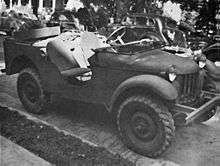
Development start – Bantam Reconnaissance Car
In the early 1930s, the Infantry Board at Fort Benning became interested in the British Army's use of the tiny Austin 7 car in a reconnaissance role, and they obtained a car from the American Austin company in Pennsylvania which built them under license. By 1938 American Austin had gone bankrupt and reorganized as American Bantam. They had loaned 3 cars to the Pennsylvania National Guard for trials during summer maneuvers. Bantam officials met with chiefs of Infantry and Cavalry and suggested a contract to further develop a military version of their car. A subcommittee of army officers and civilian engineers was tasked with created detailed specifications for the proposed vehicles. One of the first things they did was visit the Bantam factory and look at their existing compact cars. By the end of June 1940 specifications had been drawn up[34]
By now the war was under way in Europe, so the Army's need was urgent and demanding. Bids were to be received by July 22, a span of just eleven days. Manufacturers were given 49 days to submit their first prototype and 75 days for completion of 70 test vehicles. The Army's Ordnance Technical Committee specifications were equally stringent: the vehicle would be four-wheel drive, have a crew of three on a wheelbase of no more than 75 in (191 cm), later upped to 80 in (203 cm), and track no more than 47 in (119 cm). The diminutive dimensions were similar in size and weight to Bantam's compact truck and roadster models [35] It was to feature a fold-down windshield, carry a 660 lb (299 kg) payload, and be powered by an engine capable of 85 lb⋅ft (115 N⋅m) of torque. The most daunting demand, however, was an empty weight of no more than 1,300 lb (590 kg).
Initially, only American Bantam and Willys-Overland entered the competition. Ford joined later.[37] Although Willys was the low bidder, Willys was penalized for requesting more time, and Bantam received the contract, as the only company committing to deliver a pilot model in 49 days and production examples in 75.
Bantam's chief engineer, Harold Crist, who had previously worked on the first Duesenberg, and been an engineer at Stutz Motor Company of Indianapolis for 18 years,[38][14] drafted freelance Detroit designer Karl Probst to collaborate. Probst turned down Bantam initially, but agreed to work without pay after an Army request and began work on July 17, 1940.[39]
Probst laid out full design drawings for the Bantam prototype, known as the Bantam Reconnaissance Car, or BRC, in just two days, and worked up a cost estimate the next day. Bantam's bid was submitted, complete with blueprints, on July 22.[40] Bantam was struggling after bankruptcy trying to sell very small cars licensed from the British Austin Motor Company. But their design was able to leverage commercial off-the-shelf components as much as possible. Bantam adapted body stampings from its car line: the hood, cowl, dash, and curvy front fenders. As the Bantam engines only made 22 hp [41] the engine was chosen to be a 112 cu in (1.8 l) Continental four-cylinder engine making 45 horsepower and 86 lb⋅ft (117 N⋅m) of torque.[42] Custom four-wheel drive train components including the transfer case to send power to front and back axles were provided by Spicer which continues to make Jeep axles as Dana Incorporated. The axles were modified from units from the Studebaker Champion to four-wheel drive, the transmission was from Warner Gear. [43]
Using off-the-shelf automotive parts where possible had partly enabled drawing up the blueprints quickly. By working backwards, Probst and Bantam's draftsmen converted what Crist and a few others had put together into drawings.[14] The hand-built prototype was then completed in Butler, Pennsylvania,[44] and driven to the Army vehicle test center at Camp Holabird, Maryland. It was delivered on September 23, 1940. The vehicle met all the Army's criteria except engine torque. The Bantam pilot (later also dubbed the "Blitz Buggy" or "Old Number One") presented Army officials with the first of what eventually evolved into the World War II U.S. military jeep.
Enter Willys and Ford – pre-production jeeps
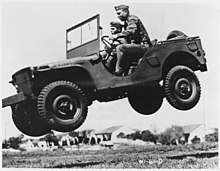
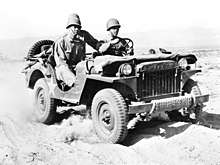
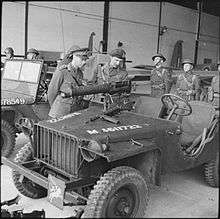
As Bantam did not have the production capacity or fiscal resources to deliver on the scale needed by the War Department, the other two bidders, Ford and Willys, were encouraged to complete their own pilot models for testing. The contract for the new reconnaissance car was to be determined by trials. As testing of the Bantam prototype took place from September 27 to October 16, Ford and Willys technical representatives present at Holabird were given ample opportunity to study the vehicle's performance. In order to expedite production, the War Department forwarded the Bantam blueprints to Ford and Willys, claiming the government owned the design. Bantam did not dispute this move due to its precarious finances. By November 1940, Ford and Willys each submitted prototypes to compete with the Bantam in the Army's trials. The pilot models, the Willys "Quad" and the Ford "Pygmy", were similar and were joined in testing by Bantam's entry, now evolved into a Mark II called the "BRC 60".[nb 7][nb 8] By then the U.S. armed forces were under such pressure that all three cars were declared acceptable and orders for 1,500 units per company were given for field testing. At this time it was acknowledged the original weight limit (which even Bantam could not meet) was unrealistic, and it was raised to 2,160 lb (980 kg).
For pre-production runs, each vehicle received revisions and a new name. Bantam's became the "BRC 40". Production began on March 31, 1941, with a total of 2,605 built up to December 6, most of them supplied to Allied nations under the Lend-Lease program.[46][36] The BRC 40 was the lightest and most nimble of the three pre-standardized models, and the Army lauded its good suspension and brakes, and high fuel economy. However, as the company could not meet the Army's demand for 75 Jeeps a day, production contracts were also awarded to Willys and Ford.[16]
After reducing the Quad's weight by 240 lb (109 kg), through many painstaking detail changes, Willys renamed their designated its vehicle "MA", for "Military" model "A". Some 1,555 MAs were built, many of which went to the Soviet Union under Lend-Lease. Only 27 units are still known to exist.[36] Ford's pre-production model went into production as the "GP", with "G" indicating a "Government" contract, and "P" chosen by Ford to designate a car with a wheelbase of 80 in (203 cm).[nb 9] With about 4,458 units built, the Ford GP became not only the most numerous of the pre-standardized jeeps [36] — it was also the first jeep fielded in significant numbers to U.S. Army units. The Ford's overall design and quality of construction had advantages over the Bantam and Willys models, but the GP's engine, an adaptation of the Model N tractor engine, was underpowered and insufficiently reliable. Fifty units were built with four-wheel steering, of which four have survived.[36]
Full production – Willys MB and Ford GPW
By July 1941, the War Department desired to standardize and decided to select a single manufacturer to supply them with the next order for 16,000 vehicles. Willys won the contract mostly due to its much more powerful 60 HP engine (the "Go Devil"), which soldiers raved about, and its lower cost and silhouette. The design features in the Bantam and Ford entries which represented an improvement over Willys's design were then incorporated into the Willys car, moving it from an "A" designation to "B", thus the "MB" nomenclature. Most notable was a flat wide hood, adapted from Ford GP.
The jeep, once it entered mass production, introduced several new automotive technologies. Having four-wheel drive for the first time introduced the need for a transfer case, and the use of constant-velocity joints on the driven front wheels and axle, to a regular production car sized vehicle.[47]
By October 1941, it became clear that Willys-Overland could not keep up with production demand, and Ford was contracted to build jeeps as well, using Willys blueprints, drawings, specifications, and patents, including the Willys engine.[48] The Ford car was then designated "GPW", with the "W" referring to the "Willys" licensed design and engine. During World War II, Willys produced 363,000 Jeeps and Ford some 280,000. Approximately 51,000 were exported to the U.S.S.R. under the Lend-Lease program.
Ford faithfully built jeeps with functionally interchangeable parts and components, in part facilitated by using components from common sources: frames from Midland Steel, wheels from Kelsey-Hayes, and axles and transfer-cases from Spicer.[49] However, there were many minor differences; the most well known: the Ford chassis had an inverted U-shaped front cross member instead of a tubular bar, and a Ford script letter "F" was stamped onto many small parts. Many body detail differences remained for as long as January 1944, when a composite body, fabricated by American Central, was adopted by both Ford and Willys. It integrated features of both designs.[36] Through the chaotic circumstances of war, sometimes peculiar deviations from regular mass production came off the assembly line, that are today prized by collectors — for instance: the earliest Ford GPWs had a Willys design frame, and in late-1943, some GPWs came with an unmodified Willys body; and in 1945 Willys produced some MBs with a deep mud exhaust system, vacuum windshield wipers, and a Jeep CJ-style parking brake.[50]
On 7 April 1942, U.S. patent 2278450 for the WW II jeep, titled "Military vehicle body" was awarded to the U.S. Army, which had applied for it, listing Colonel Byron Q. Jones as the inventor on the patent, though he had performed no work on the design of the vehicle.[51] Filed on 8 October 1941, stating in the application that "The invention described herein, if patented, may be manufactured and used by or for the Government for governmental purposes without the payment of any royalty thereon",[52] the patent relates to a "small car vehicle body having convertible features whereby it is rendered particularly desirable for military purposes" and describes the purpose of the vehicle as being to create the automobile equivalent of a Swiss Army knife:
"One of the principal objects of the invention is to provide a convertible small car body so arranged that a single vehicle may be interchangeably used as a cargo truck, personnel carrier, emergency ambulance, field beds, radio car, trench mortar unit, mobile anti-aircraft machine gun unit, or for other purposes." [52]
The Ford GPA, the amphibious jeep
A further roughly 13,000 amphibious jeeps were built by Ford under the name GPA (nicknamed "Seep" for "Sea Jeep"). Inspired by the larger DUKW, the vehicle was produced too quickly and proved to be too heavy, too unwieldy, and with insufficient freeboard. In spite of participating successfully in the Sicily landings in July 1943, most GPAs were routed to the U.S.S.R. under the Lend-Lease program. The Soviets were sufficiently pleased with its ability to cross rivers to develop their own version of it after the war, the GAZ 46 MAV.
Etymology
.jpg)
There is no consensus among historians as to how the U.S. Army's World War II quarter-ton reconnaissance car became known as the "jeep", let alone how the word originated in the first place. Explanations have proven difficult to verify. With certainty, the term "jeep" was already in use before the war, designating various things, while early jeeps were indicated by many designations and nicknames.
Eugene the Jeep and prior usage of "jeep"
As early as spring 1936, a character called Eugene the Jeep was created in E. C. Segar's Popeye cartoons.[5] Eugene the Jeep was Popeye's "jungle pet" and was small, able to walk through walls and move between dimensions, and could go anywhere and solve seemingly impossible problems.[54][55] According to some sources, the word "jeep" was used as early as World War I, both as U.S. Army slang for new, uninitiated recruits or other new personnel who still had to prove their mettle. It was also used by mechanics, to refer to any new prototypes or untested vehicles.[3][56] The Eugene cartoon character brought new meaning to the Jeep name, diverging from the initial, somewhat pejorative meaning of the term, instead changing the slang to mean a capable person or thing.[57]
Eugene the Jeep's go-anywhere ability resulted in various industrial and four-wheel drive vehicles getting nicknamed "Jeep" in the late-1930s. Around 1940, converted 4WD Minneapolis-Moline tractors, supplied to the U.S. Army as prime movers, were called "jeeps",[58][59][nb 10] and Halliburton used the name for an electric logging device,[3][60] or for a custom built four wheel drive exploration/survey vehicle.[57] A small, anti-submarine, escort aircraft carrier was called a "jeep carrier" in the U.S. Navy in WWII,[61][62] and also several aircraft – prototypes for both Kellett autogyros, and for the Boeing B-17 Flying Fortress,[57][63] as well as the 1941 Curtiss-Wright AT-9 were called "jeeps".
By 1940–1942, soldiers generally used "jeep" for half-ton or three-quarter-ton Dodge Command Reconnaissance cars, with the three-quarter-ton Command Cars sometimes called "beeps" (for "big Jeeps"), while the quarter-ton cars were called "peeps", "son of jeep", "baby jeep", or "quads" or "bantams".[3][59][60] A seven page article in Popular Science (Oct 1941) headlined introducing the quarter-ton as "Leaping Lena", and called it a buggy, or just a bug.[47] Originally, "peep" seemed a fitting name, because the quarter-ton was considered primarily a reconnaissance (peeping) car.[60]
The early-1940s terminology situation is summed up in the definition given in Words of the Fighting Forces by Clinton A. Sanders, a dictionary of military slang, published in 1942, in the Pentagon library: "Jeep: A four-wheel drive car of one-half to one-and-one-half-ton capacity for reconnaissance or other army duty. A term applied to the bantam-cars, and occasionally to other motor vehicles (U.S.A.) in the Air Corps, the Link Trainer; in the armored forces, the 1⁄2 ton command car. Also referred to as 'any small plane, helicopter, or gadget'". "Jeep" could still mean various things, including light wheeled utility vehicles other than the jeep.
Whether "jeep" was derived from "GP"
One of the most frequently given explanations is that the designation "GP" (either from the initial Ford "GP", or from the military G.P. for "General Purpose" car) was slurred into the word "Jeep" in the same way that the contemporary "HMMWV" (for "High-Mobility Multi-purpose Wheeled Vehicle") has become known as the Humvee. Although prior existence of the term "jeep" dismisses this as an etymology in the proper sense, it may well have contributed to the marriage of the term with the WWII quarter-ton truck. The first version (based on the Ford "GP" model code) was already given in an article in the San Francisco Call-Bulletin in late 1941,[64] and is to an extent plausible, because the Ford GP was the first of the pre-standardized jeeps to reach GIs by the hundreds, starting early in 1941. So it is possible "GP" could have evolved into "Geep" and finally "jeep".[42] The latter explanation (from the term "general purpose"), though this does appear in the TM9-803 Manual (page 10),[1] and the car is designated a "GP" in the TM9-2800 Manual — these were published in late 1943 and early 1944, and their influence on the jeep's name is dubious. Moreover, the jeep wasn't the only of the Quartermaster Corps' "general purpose" vehicles – so if this was the source, people would have nicknamed the others "geeps" or "jeeps" as well.[65]
Willys-Overland's positions and promotion
Joe Frazer, Willys-Overland President from 1939 to 1944, claimed to have coined the word jeep by slurring the initials G.P.,[63] possibly related to Willys-Overland's 1946 copyright claim to the Jeep name. However, the company handling Willys' public relations in 1944 wrote that the jeep name probably came from the fact that the vehicle made quite an impression on soldiers at the time, so much so that they informally named it after the go-anywhere Eugene the Jeep.[64]
In early 1941, when the test cars went by names like BRC / "Blitz-Buggy", Ford Pygmy and such, Willys-Overland staged a press event in Washington, D.C., a publicity stunt and Senate photo opportunity demonstrating the car's off-road capability by driving it up the Capitol steps. Irving "Red" Hausmann, a test driver on the Willys development team who had accompanied the car for its testing at Camp Holabird, had heard soldiers there referring to it as a jeep. He was enlisted to go to the event and give a demonstration ride to a group of dignitaries, including Katherine Hillyer, a reporter for the Washington Daily News. When asked what it was, Hausmann said "it's a Jeep". Hausmann preferred "Jeep", to distinguish the Willys rig from the other funny-named quarter-tons at Camp Holabird.[59] Hillyer's syndicated article appeared in the newspaper on February 20, 1941, with a photo showing a jeep going up the Capitol steps and a caption including the term "jeep". This is believed to be the most likely origin of the term being fixed in public awareness. Even though Hausmann did not create or invent the word "Jeep", he likely contributed to its mainstream media usage indicating the quarter-ton vehicle.
Convergence from mixed origins and media coverage
It is plausible that the origin was mixed and converged on "jeep" from multiple directions. Ford Motor Company pushed its Ford GP hard, to get the military contract, putting the term "GP" into use. Military officers and G.I.s involved in the procurement and testing of the car may have called it jeep from the WWI slang. Civilian contractors, engineers, and testers may have related it to Popeye's "Eugene the Jeep" character. People may have heard the same name from different directions, and as one person heard it from another, put their own understanding and explanation on it.[67] Overwhelming presence of the nickname 'jeep' in the public's opinion was probably the deciding factor.[57]
From 1941 on, a "constant flow of press and film publicity",[19] as well as Willys advertising as of 1942, proclaiming it had created and perfected the jeep, cemented the name "Jeep" in the civilian public's mind,[60][18] even when "peep" was still used at many army camps,[19] and President Roosevelt spoke of the vital role the "peep" had to play in defending the shores of Fort Story, Virginia (04-1942).
One other particularly influential article may have been the January 1942 full review of the military's new wonder buggy in Scientific American, reprinted as "Meet the Jeep" in Reader's Digest, the best-selling consumer magazine of the day.[68] Author Jo Chamberlin was duly impressed by the "midget combat car" and wrote:
"Our Army's youngest, smallest toughest baby has a dozen pet names such as jeep, peep, blitz-buggy, leaping Lena, panzer-killer. The names are all affectionate, for the jeep has made good. Only a year old, it stole the show in Louisiana. Now the Army plans to have 75,000 of them." In a prescient footnote, Chamberlin wrote: "Some army men call the bantam a "peep", reserving "jeep" for the larger command car in which the brass hats ride. However, the term 'jeep' (born of GP, an auto manufacturing classification) is used by newspapers and most soldiers, and apparently will stick'".[69][70]
Grille
Willys made its first 25,000 MB Jeeps with a welded flat iron "slat" radiator grille. It was Ford who first designed and implemented the now familiar and distinctive stamped, vertical-slot steel grille into its Jeep vehicles, which was lighter, used fewer resources, and was less costly to produce.[71] Along with many other design features innovated by Ford, this was adopted by Willys and implemented into the standard World War II Jeep by April 1942.
In order to be able to get their grille design trademarked, Willys gave their post-war jeeps a seven slot grille instead of the original Ford nine-slot design.[71] This applies both to Willys' "Civilian Jeeps", as well as the M38 and M38A1 military models. Through a series of corporate takeovers and mergers, AM General Corporation ended up with the rights to use the seven-slot grille as well, which they in turn extended to Chrysler when it acquired American Motors Corporation, then manufacturer of Jeep, in 1987.
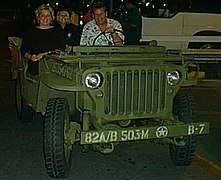 Ford design, stamped steel, nine-slot grille on a 1945 Willys MB.
Ford design, stamped steel, nine-slot grille on a 1945 Willys MB..jpg) Seven slot grille on the CJ-2A, Willys' first civilian Jeep
Seven slot grille on the CJ-2A, Willys' first civilian Jeep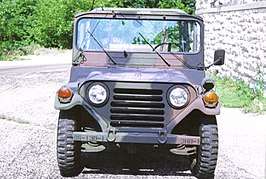 Due to Willys' trademark, Ford had to use a different design on their M151 U.S. jeep, opting for horizontal slots.
Due to Willys' trademark, Ford had to use a different design on their M151 U.S. jeep, opting for horizontal slots..jpg) Through corporate history, the Humvee manufacturer AM General also had rights to fit the seven-slot grille.
Through corporate history, the Humvee manufacturer AM General also had rights to fit the seven-slot grille.- The jeep inspired other manufacturers to copy the design — pictured a 1st generation Suzuki Jimny.
Service
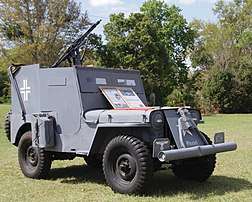
The USA provided jeeps to most or all of the Allies in World War II. Britain, Canada,[nb 12] Australia, India, the Free French, China and Russia all received jeeps, mostly under the American Lend-Lease program.[13] Some 80,000 jeeps were shipped to the Soviet Union,[12] [nb 13] consisting of 49,250 jeeps,[nb 14] 25,200 Dodge 3⁄4-tons, and 3,520 GPA Seeps.[9] Within the U.S military, jeeps were used by every branch. In the U.S. Army, an average of 145 units were assigned to each infantry regiment.[73] Around the world, jeeps took part in every theater of war overseas — in Africa and the Pacific Theater, the Western Allied invasion of Europe in 1944, as well as the Eastern Front. Jeeps became so ubiquitous in the European battle theater that some German troops believed that each American soldier was issued their own jeep.[74][nb 15]
In the North Africa deserts, the jeep's abilities so far surpassed those of British vehicles that it wasn't unusual for jeeps to rescue a three-ton truck stuck in the sand. In combat, the British would use their jeeps in groups of up to fifty or sixty to raid Rommel's lines by surprise, exploiting the jeep's low silhouette; able to remain unseen, hide behind dunes, and surprise the enemy.[77]
Jeeps served as indefatigable pack horses for troop transport and towing supply trailers, carrying water, fuel and ammo, and pulling through the most difficult terrain. They performed nimble scout and reconnaissance duty, were frequent ambulances for the wounded, and did hearse service. They also doubled as mobile field command headquarters or weapons platforms – either with mounted machine guns or pulling small artillery pieces into "unreachable" areas over inhospitable terrain.[14] The Jeep's flat hood was used as a commander's map table, a chaplain's field altar, the G.I.s' poker table, or even for field surgery. Some of them had a wire cutter as protection against taut-wire traps. Fitted with flanged steel wheels, they could pull railroad cars.[12][13][14] Despite some shortcomings, the jeep was generally well-liked, seen as versatile, maneuverable, dependable, and almost indestructible.[13] The seats were found uncomfortable, sometimes caused the so called "Jeep riders' disease" and cramped in the rear, but many soldiers enjoyed driving the nimble jeep, appreciating its powerful engine; and with its light weight, low-cut body sides, bucket seats and manual floor-shifter, it was as close to a sportscar as most GIs had ever driven.[12] Enzo Ferrari famously called the Jeep "America's only real sports car." [74]
In the cauldron of war, the jeeps served every purpose imaginable: as a power plant, light source, improvised stove for field rations, or a hot water source for shaving. Hitched-up with the proper tools, it would plow snow, or dig long furrows for laying heavy electrical cable along jungle airfields – laid by another jeep following it.[14] Battle-hardened warriors learned to weld a roof-top height vertical cutter-bar to the front of their jeeps, to cut any trip wires tied across roads or trails by the Germans, placed to snap the necks of unsuspecting jeepers.[12] Pulitzer Prize–winning war journalist Ernie Pyle wrote: "It does everything. It goes everywhere. It's as faithful as a dog, as strong as a mule and as agile as a goat. It constantly carries twice what it was designed for, and still keeps on going."[6]
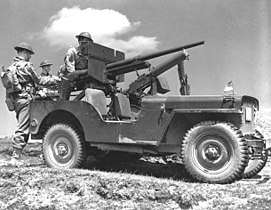 Jeep with a 37mm cannon and M1917 Browning machine gun in US 3rd Infantry, Newfoundland, 1942
Jeep with a 37mm cannon and M1917 Browning machine gun in US 3rd Infantry, Newfoundland, 1942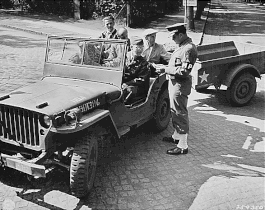 The World War II jeep with Bantam trailer, Potsdam, Germany
The World War II jeep with Bantam trailer, Potsdam, Germany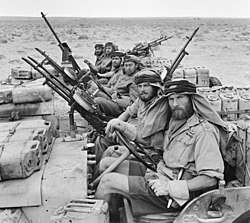 The British SAS used heavily armed jeeps in North Africa missions
The British SAS used heavily armed jeeps in North Africa missions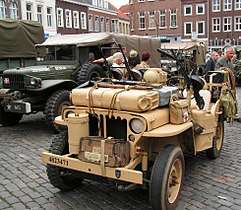 SAS outfitted jeep – 2007 Santa Fe Event in Roermond, the Netherlands
SAS outfitted jeep – 2007 Santa Fe Event in Roermond, the Netherlands
Post-war
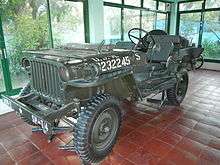
.jpg)
Willys-Overland filed to trademark the "Jeep" name in 1943.[78] From 1945 onwards, Willys marketed its four-wheel drive vehicle to the public with its CJ (Civilian Jeep) versions, making these the world's first mass-produced 4WD civilian cars. Even before actual civilian purpose jeeps had been created, the Jan 3, 1944 issue of Life magazine featured a story titled: 'US Civilians Buy Their First Jeeps'. A mayor from Kansas had bought a Ford GP in Chicago in 1943, and it performed invaluable work on his 2000 acre farm. [79]
Already in 1942 industrial designer Brooks Stevens came up with an idea on how to make a civilian car called Victory Car on the Jeep chassis. It never went into production but Willys liked the idea and Brook Stevens got more assignments, including the Willys Jeep Station Wagon in 1946.[80]
In 1948, the U.S. Federal Trade Commission agreed with American Bantam that the idea of creating the Jeep was originated and developed by the American Bantam in collaboration with the U.S. Army as well as Ford and Spicer.[81] The commission forbade Willys from claiming, directly or by implication, that it had created or designed the Jeep, and allowed it only to claim that it contributed to the development of the vehicle.[56][16] The trademark lawsuit initiated and won by Bantam was a hollow victory: American Bantam went bankrupt by 1950 and Willys was granted the "Jeep" trademark the same year.[81][82]
The first CJs were essentially the same as the MB, except for such alterations as vacuum-powered windshield wipers, a tailgate (and therefore a side-mounted spare tire), and civilian lighting. Also, the civilian jeeps had amenities like naugahyde seats, chrome trim, and were available in a variety of colors. Mechanically, a heftier T-90 transmission replaced the Willys MB's T84 in order to appeal to the originally considered rural buyer demographic.
In Britain, Rover was also inspired to build their own jeep-like vehicle. Their first testing prototype was actually built on the chassis of a battered war-surplus jeep on a Welsh farm, and Land Rover production started after its presentation model was well-received at the 1948 Amsterdam auto show.[14]
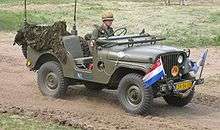

Willys-Overland and its successors, Willys Motors and Kaiser Jeep continued to supply the U.S. military, as well as many allied nations with military jeeps through the late 1960s. In 1950, the first post-war military jeep, the M38 (or MC), was launched, based on the 1949 CJ-3A. In 1953, it was quickly followed by the M38A1 (or MD), featuring an all-new "round-fendered" body in order to clear the also new, taller, Willys Hurricane engine. This jeep was later developed into the civilian CJ-5 launched in 1955. Similarly, its ambulance version, the M170 (or MDA), featuring a 20-inch wheelbase stretch, was later turned into the civilian CJ-6.
Before the CJ-5, Willys offered the public a cheaper alternative with the taller F-head, overhead-valve engine, in the form of the 1953 CJ-3B, simply using a CJ-3A body with a taller hood. This was quickly turned into the M606 jeep (mostly used for export, through 1968) by equipping it with the available heavy-duty options such as larger tires and springs, and by adding black-out lighting, olive drab paint, and a trailer hitch. After 1968, M606A2 and -A3 versions of the CJ-5 were created in a similar way for friendly foreign governments.[nb 16]
Licenses to produce jeeps, especially CJ-3Bs, were issued to manufacturers in many different countries, and some, such as Mahindra and Mahindra Limited in India, continue to produce them in some form or another to this day. Chinkara Motors of India produces the Jeepster, [83] with FRP body. The Jeepster can be delivered a diesel engine or the 1.8L Isuzu petrol.[84]
In France, the army used Hotchkiss M201 jeeps – essentially licensed Willys MBs. In Japan, Mitsubishi's first jeeps were versions of the CJ-3B, and in 1950 Toyota Motors was given an order by U.S. forces to build a vehicle to Jeep specifications, resulting in Toyota's BJ and FJ series of utility vehicles, slightly bigger and more powerful jeep-type vehicles.[14]
The compact military jeep continued to be used in the Korean and Vietnam Wars. In Korea, it was mostly deployed in the form of the MB, as well as the M38 and M38A1 (introduced in 1952 and 1953), its direct descendants. In Vietnam, the most used jeep was the then newly designed Ford M151, which featured such state-of-the-art technologies as a unibody construction and all around independent suspension with coil-springs. The M151 jeep remained in U.S. military service into the 1990s, and many other countries still use small, jeep-like vehicles in their militaries.
Apart from the mainstream of — by today's standards — relatively small jeeps, an even smaller vehicle was developed for the US Marines, suitable for helicopter airlifting and manhandling, the M422 "Mighty Mite".
Eventually, the U.S. military decided on a fundamentally different concept, choosing a much larger vehicle that not only took over the role of the jeep, but also replaced all its other light wheeled vehicles: the HMMWV ("Humvee").[nb 17]
In 1991, the Willys-Overland Jeep MB was designated an International Historic Mechanical Engineering Landmark by the American Society of Mechanical Engineers.[15]
Jeep Wrangler
The Jeep brand has changed owners from Willys to Kaiser, American Motors, and Chrysler and remains successful to this day. The American Motors Wrangler redesign replaced the CJ series with suspension, drivetrain, and interior from the 1984 Cherokee (XJ) model is arguably an indirect progression from the World War II Jeep. It still looks like a Jeep from grille and profile and offers a compact, open-topped body on frame, with part-time four-wheel drive, solid live axles, and high and low gearing. It can even still be driven with the doors off and the windshield folded forward. Aside from a generally increased level of sophistication to keep the car up to date, and occasional redesigns, the only significant departure was replacing leaf springs with coil springs in 1995. In contrast to the original MB with 3 seats and 60 hp, the 2020 Wrangler offers most of the refinements of contemporary cars with a 4 door that seats 5 with gross vehicle weight of 5,300 lbs and has a V-6 that produces 285 hp. By contrast, the original rear engine Volkswagen Beetle which has one of the longest automobile production runs was produced 65 years from 1938–2003, but there is no end in sight to continued evolution of Jeep Wrangler production.
Postwar conversions
Filipino jeepney
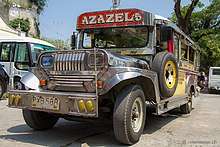
When American troops began to leave the Philippines at the end of World War II, hundreds of surplus jeeps were sold or given to local Filipinos. The Filipinos stripped down the jeeps to accommodate several passengers, added metal roofs for shade, and decorated the vehicles with vibrant colors and bright chrome hood ornaments.
The jeepney rapidly emerged as a popular and creative way to reestablish inexpensive public transportation, which had been virtually destroyed during World War II. Recognizing the widespread use of these vehicles, the Philippine government began to place restrictions on their use. Drivers now must have specialized licenses, regular routes, and reasonably fixed fares.
Argentine Autoar
Starting in 1950, a Jeep-engined utility vehicle was produced by Autoar in Argentina. Starting from 1951, a new sedan was introduced using the same 2199 cc Jeep engine and manual transmission. It was fitted with overdrive to compensate for the Jeep's low axle ratio. In 1952, a new overhead valve 3-litre six-cylinder was announced, but was probably never built. At that time, Piero Dusio returned to Italy. In the 1950s, production was sporadic, and models built included a station wagon with a Jeep-type 1901 cc engine.
Commemorative edition
Inspired by the U.S. Army Willys MB, Jeep produced about 1000 Willys editions of the 2004 Wrangler TJ, and hoped to sell twice that number for the 2005 model year.[85]
Production numbers
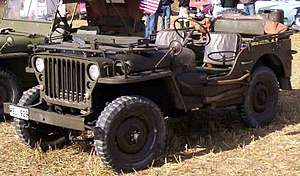
| Model | Year | Number built |
|---|---|---|
| Bantam pilot | 1940 | 1 |
| Bantam Mk II / BRC-60 [nb 8] | 1940 | 70 |
| Ford Pygmy | 1940 | 1 |
| Ford Budd | 1940 | 1 |
| Willys Quad | 1940 | 2 |
| Bantam BRC-40 [nb 18] | 1941 | 2,605 |
| Ford GP | 1941 | 4,456 |
| Willys MA | 1941 | 1,553 |
| Willys MB | 1941–1945 | 361,339 (335,531 + 25,808 "slats") |
| Ford GPW | 1942–1945 | 277,896 |
| World War II Total | 1940–1945 | 647,925 |
| Other | ||
| Ford GPA "Seep" | 1942–1943 | 12,778 |
| Post-war | ||
| Willys M38 (MC) | 1950–1952 | 61,423 |
| Willys M38A1 (MD) | 1952–1957 | 101,488 |
| Willys M606 (CJ-3B) | 1953–1968 | ? (part of 155,494 CJ-3Bs produced) |
| Willys M170 | 1954–1964 | 6,500 |
Gallery
- 1940 Bantam Mk II / BRC-60
.jpg) Ford Pygmy
Ford Pygmy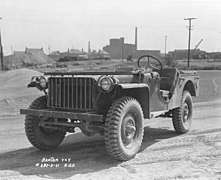 Bantam BRC 40
Bantam BRC 40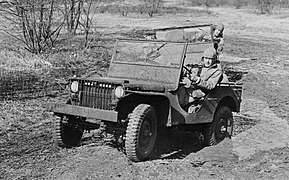 Ford GP
Ford GP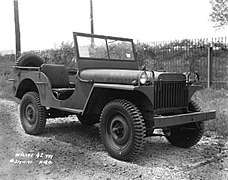 Willys MA
Willys MA World War II era photo of slat grill stationed in Alaska
World War II era photo of slat grill stationed in Alaska Jeep with top up
Jeep with top up Willys MB showing rear quarter panel, split combat rims, spare gas can and spare wheel
Willys MB showing rear quarter panel, split combat rims, spare gas can and spare wheel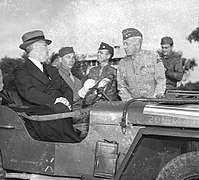 Franklin Roosevelt meeting George Patton in a jeep, Casablanca, French Morocco, 1943
Franklin Roosevelt meeting George Patton in a jeep, Casablanca, French Morocco, 1943 Winston Churchill in a jeep at the German Reichstag touring the ruins of Berlin, 16 July 1945
Winston Churchill in a jeep at the German Reichstag touring the ruins of Berlin, 16 July 1945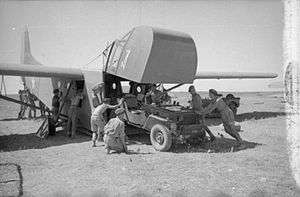 Preparing for the July 1943 Sicily campaign: a jeep is loaded onto an American Waco CG-4A glider plane.
Preparing for the July 1943 Sicily campaign: a jeep is loaded onto an American Waco CG-4A glider plane..jpg) Ford GPA amphibious jeep
Ford GPA amphibious jeep US Army Willys MB at Virginia War Museum
US Army Willys MB at Virginia War Museum
 Rail Jeep conversion to a switch engine in Australia, 1943
Rail Jeep conversion to a switch engine in Australia, 1943 Jeep model in 1/72 scale
Jeep model in 1/72 scale Sheikh Hamad bin Hamdan Al Nahyan with largest model Willys Jeep (scale 4/1).
Sheikh Hamad bin Hamdan Al Nahyan with largest model Willys Jeep (scale 4/1)..jpg) Japanese American WW II veterans in jeep in memorial parade.
Japanese American WW II veterans in jeep in memorial parade.
See also
- Austin Champ
- Dodge WC series
- Fath Safir (Iran)
- Ford GPA (amphibious)
- G-numbers (G503)
- GAZ-64 and GAZ-67
- Hafner Rotabuggy
- IAME Rastrojero
- Jeep trailer
- Jeep train
- Jonga
- Kurogane Type 95
- Land Rover (original series)
- List of U.S. military jeeps
- Mahindra Thar
- Mahindra Roxor
- M151 Truck, Utility, l/4-Ton, 4×4
- M422 Mighty Mite
- Military light utility vehicle
- Volkswagen Kübelwagen
- Willys FAMAE Corvo
In popular culture
In Disney / Pixar's Cars films, the character Sarge (voiced by Paul Dooley) is based on a 1941 Willys jeep.
The Grateful Dead’s song Sugar Magnolia contains the lyric “Jump like a Willys in four wheel drive”.
In the video game Fallout 76, a slightly modified version of the Willy’s MB jeep can be found across the map.
The 1945 model is available in several of the Forza racing games.[86]
Footnotes
- Nominal off-road payload rating
- Nominal off-road payload rating
- Although the dashboard caution plate indicated only 60 mph (97 km/h) in 3rd high.[1]
- According to its U.S. Army Ordnance Corps Supply Catalog designation, 'G-number', or SNL nr. — a group number for ordering parts, based on a Standard Nomenclature List.
- The others being the bulldozer, the amphibious "Duck" truck, the 2½-ton 6x6 truck, and the C-47 airplane.[11]
- Phil Patton was a design journalist, curator, and author. He wrote regularly about automobile design for the New York Times.
- for "Bantam Reconnaissance Car".
- New research into identification of the earliest jeeps suggests Bantam simply referred to these as the '40 BRC.[45]
- Ford's GP designation did not represent "general purpose" – that was a government description.
- Willys had owned Moline, but sold it long before the war.[60]
- ”Larry” is Seaman 2/c Lawrence Meyer, the first Seabee to receive the Silver Star at the Battle of Guadalcanal.[66]
- Though Canada itself built large numbers of light and medium trucks in the war, it relied on the States for its jeeps.
- 77,972 units from the U.S. alone [72]
- Including early, pre-production models.
- By war's end, in 1945, in the European theater U.S. forces had close to one motor truck (jeeps included) for every four men [75] — worldwide it had one vehicle per seven American GIs.[76]
- In the early 1980s, the Canadian Army took delivery of 195 militarized units of the CJ-7. These were put into service as a stopgap measure between the retirement of the M38A1 and the introduction of the Iltis. They were codified by the Canadian Forces with the Equipment Configuration Code (ECC) Number 121526.
- The HMMWV was generally very successful, but a few U.S. military units kept a small number of M151s in reserve for applications where the Humvee was simply too large or too heavy
- New research into identification of the earliest jeeps suggests Bantam referred to these as the '41 BRC.[45]
Reference notes
- TM9-803 ¼-ton 4x4 Truck (Willys-Overland Model MB and Ford Model GPW) (PDF). Technical manual. US War Department. 22 February 1944. pp. 10–14. Archived (PDF) from the original on 23 June 2018. Retrieved 26 May 2015.
- U.S. Ordnance Standard Nomenclature List – G-503 (Willys MB / Ford GPW). War Department. pp. 11–15 – via Internet Archive.
- Zaloga, Steven J. (2011). Jeeps 1941–45. Bloomsbury Publishing. ISBN 9781780961477. Retrieved 27 January 2018.
- TM 9-2800 – Standard Military Motor Vehicles. U.S. War Department. 1 September 1943. pp. 136–137.
- "Vehicle Profiles: Jeep Willys". The ClassicCars.com Journal. 2 July 2008. Retrieved 8 November 2018.
- Hyde, Charles K. (2013). Arsenal of Democracy; The American Automobile Industry in World War II (Ebook ed.). Detroit: Wayne State University Press. p. 152. ISBN 9780814339510. Retrieved 28 December 2018.
- Thomson & Mayo (2003), page 296.
- Counting 2,382,311 trucks across the four main payload classes,[6] plus 116,394 tractor trucks (34,295 military, and 82,099 commercially procured), and some of the 224,272 other vehicles, for a total of roughly 2.6 million units.[7]
- U.S. Ordnance Corps (31 December 1946). "III-B "Ordnance - Motor Transport Vehicles", Part I". Quantities of Lend-Lease Shipments (PDF) (Report). U.S. War Department. p. 1. Archived (PDF) from the original on 31 December 2018. Retrieved 11 May 2019.
- Elphick, James (5 May 2017). "7 Tools that Helped America win WW II". We Are The Mighty. Retrieved 24 June 2018.
- Dwight D. Eisenhower (1948). Crusade in Europe. Doubleday (US) / Heinemann (UK). p. 163/164. ISBN 9780801856686. OCLC 394251.
- Foster, Patrick R. (2014). Jeep: The History of America's Greatest Vehicle. Motorbooks. pp. 11–13. ISBN 9780760345856. Retrieved 30 January 2018.
- "The Jeep: An American Icon". National Museum of the United States Army. 16 July 2012. Retrieved 27 January 2018.
- Bennett, Ralph Kinney (9 April 2010). "The Elegant Jeep". The American. American Enterprise Institute. Retrieved 27 January 2018.
- American Society of Mechanical Engineers (1991).
- Pulos, Arthur J. (1988). The American Design Adventure, 1940–1975. MIT Press. p. 20. ISBN 9780262161060. Retrieved 26 May 2015.
- Ackerson, Robert C. (2006). Jeep CJ 1945-1986. Veloce Publishing. pp. 7–8. ISBN 9781904788966. Archived from the original on 12 May 2019. Retrieved 27 January 2018.
...several military officers who regarded the Jeep as "a universal idea, which no one person invented, created or discovered ... an evolution not an invention ... the fruit of specifications defined by the military over a long period.
- Patton, Phil (23 April 2012). "Design by Committee: the Case of the Jeep". Phil Patton blog. Retrieved 27 January 2018.[nb 6]
- Hogan, Lt. E.P. (1941). "The Story of the Quarter-Ton, The Army's Smallest Car Known as a "Jeep"" (PDF). The Quartermaster Review. Vol. XXI no. 2. Washington D.C.: The Quartermaster Association. pp. 53–54, 82–84. Retrieved 22 February 2018.
- Vintage Monday: Marmon-Herrington Trucks; The Jeep's Grandfather – Off Road Xtreme
- Allen, Jim (7 December 2016). "1943 Dodge WC-51 Weapons Carrier, Power & Glory: Backward Glances". FourWheeler.com. Extreme Ventures, LLC. Retrieved 24 February 2018.
- Senefsky, Bill (31 July 2007). "1916 To 1975 Dodge Diesel Engines - Dodge's First Diesels". Truck Trend. Retrieved 2 October 2018.
- Ackerson (2006), Page 8 (archived).
- Foster, Patrick R. (15 July 2014). Jeep: The History of America's Greatest Vehicle. Minneapolis, MN: Motorbooks. pp. 22–23. ISBN 9780760345856. Retrieved 27 January 2018.
- "View topic – The History of Jeep". links4jeeps. 24 February 2007. Archived from the original on 17 July 2015. Retrieved 26 May 2015.
- "Jeep 1941 – 2001". difflock.com. Archived from the original on 15 April 2012. Retrieved 26 May 2015.
- ""Baby" Truck Aids Army Scouts and Raiders". Popular Mechanics. Vol. 60 no. 5. Chicago: Hearst Magazines. November 1933. ISSN 0032-4558. Archived from the original on 11 May 2019. Retrieved 12 May 2019.
- Thomson, Harry C.; Mayo, Lida (2003). "Chapt. XII - Motor Transport Vehicles". The Ordnance Department: procurement and supply (PDF). United States Army in World War II; The Technical Services. Washington, D.C.: Center of Military History, U.S. Army (Originally published: 1960, Washington, D.C., Office of the Chief of Military History, Dept. of the Army). p. 270. LCCN 74014697.
- Fowler, Will (1993). Jeep Goes to War – a pictorial chronicle. Courage Books. ISBN 9781561382354.
- Fisher, Lindsey (11 August 2014). "Vintage Monday: Marmon-Herrington Trucks; The Jeep's Grandfather". Off Road Xtreme. Retrieved 2 October 2018.
- Hyde (2013), pages 147–148 .
- Doyle, David (2019). Chevrolet G-506 – 1 1⁄2-ton 4x4 Development, Production and Variants in WW2. Branchville, NJ: Portrayal Press. p. 8. ISBN 9780938242062. Archived from the original on 8 April 2019.
- Ackerson (2006), Pages 16–17.
- Army Research and Development Magazine January-February 1978: 20 years to develop -The Jeep. 1978. p. 14.
|access-date=requires|url=(help) - Austin, Bantam, and Willys: Birth of the Jeep by Curtis Redgap
- Jeeps in Olive Drab – FourWheeler.com
- Borth, Christy (1945). Masters of Mass Production. p. 220. Retrieved 26 May 2015.
- Austin, Bantam, and Willys: Birth of the Jeep – Allpar.com
- Jeep History Through The Years on Everyman Driver
- "The Military Jeep". Cossor.com.au. Archived from the original on 29 May 2010. Retrieved 12 March 2010.
- 1938-1941 American Bantam
- Allen, Jim (10 January 2016). "Origins Of The Jeep: Birthing A 75-Year Legend". FourWheeler.com. Extreme Ventures, LLC. Retrieved 22 February 2018.
- How Stuff Works 1906-1939 Jeep
- "Invention of the Jeep - Pennsylvania Historical Markers". Waymarking.com. 9 March 2006. Retrieved 23 February 2012.
- Smith, Stephen H. (7 December 2015). "Earliest Jeeps Built 75-Years Ago for WWII". York Daily Record. Retrieved 27 January 2018.
- Allen, Jim (2003). Jeep. Motorbooks International. p. 28. ISBN 9780760314869. Retrieved 26 May 2015.
- Stearns, David M. (October 1941). "Leaping Lena Joins the Army". Popular Science. Vol. 139 no. 4. pp. 52–58. ISSN 0161-7370. Archived from the original on 14 May 2019. Retrieved 14 May 2019.
- Thomson & Mayo (2003), page 277–278.
- Thomson & Mayo (2003), page 278.
- The Jimmy's Ancestry; The CCKW in Detail and The Collector's Syndrome — Bryce Sunderlin in Army Motors #47, p.19 (MVPA)
- 75th Anniversary of the Original Jeep Patent - IPWatchdog.com – Patents & Patent Law
- "Patent 2,278,450: Military Vehicle Body". Retrieved 30 January 2018.
- Doyle, David (2011). Standard Catalog of U.S. Military Vehicles - 2nd Edition. Iola, Wisconsin: Krause Publications. p. 85. ISBN 9781440225727.
- Wilton, Dave (12 July 2006). "Jeep". Wordorigins.org. Retrieved 27 January 2018.
- Borth, Christy (1945). Masters of Mass Production. Indianapolis, IN: Bobbs-Merrill. pp. 208–236.
- Ware, Pat (2010). Military Jeep Manual: An insight into the history, development, production and role of the US Army's light four-wheel-drive. Haynes. p. 39. ISBN 9781844259335.
- Will The Real Jeep Please Stand Up – Offroaders.com
- The Industrial Jeep - 1943 NTX - Minneapolis-Moline's – Hemmings Motor News
- Morr, Tom; Brubaker, Ken (2007). Jeep Off-Road. MotorBooks International. p. 11. ISBN 9781610590563. Retrieved 27 January 2018.
- Massey, Ken; Zatz, David. "How the Jeep got its name". allpar.com. Retrieved 27 January 2018.
- Jeep carrier – Define Jeep carrier at Dictionary.com
- Bryan, B.J. (19 March 2011). The Ship That Never Was. Xlibris Corporation. p. 131. ISBN 9781456877682. Retrieved 20 February 2018.
- Brown, Arch (2001). Jeep: The Unstoppable Legend. Publications International. p. 42. ISBN 978-0-7853-5562-5.
- Dickson, Paul (1 August 2014). War Slang: American Fighting Words & Phrases Since the Civil War, Third Edition. Courier Corporation. p. 178. ISBN 9780486797168.
...from an article by Marsh Maslin in the San Francisco Call-Bulletin of November 22, 1941: 'Do you know why those swift little army cars are called 'jeeps'? It's Model G-P produced by that automobile manufacturer—and G-P easily becomes 'jeep'.'
- Cowdery, Ray (2 March 2013). "How the Jeep got its name..." Charlie Company Vietnam 1966-1972. Retrieved 12 May 2019.
- https://seabeemagazine.navylive.dodlive.mil/2015/03/04/fires-to-the-sky-the-legend-of-bucky-meyer/
- "Origin of the Term Jeep". olive-drab.com. Retrieved 20 February 2018.
- How Americans got to meet the Jeep in 1942 – Automotive News.com
- Why it's a 'Jeep' and not a 'Leaping Lena' – Automotive News.com
- Where the Jeep name first came from – AutoWeek.com
- Torchinsky, Jason (20 February 2015). "The Iconic Face Of The Jeep Was Actually Designed By Ford". Jalopnik. Retrieved 27 January 2018.
- Lend-Lease tanks and aircrafts [sic] for Russia 1941-1945
- WWII Jeep in a Crate for $50 - fact or a tall story – War History Online
- Jeep – World War II Database
- Thomson & Mayo (2003), page 265.
- Taylor, Peter Shawn (19 April 2016). "The Trucks that Beat Hitler". National Post. Postmedia Network. Retrieved 9 May 2018.
- Ackerson (2006), Page 73 (archived).
- "JEEP Trademark of WILLYS-OVERLAND MOTORS, INC. - Registration Number 0526175 - Serial Number 71458520". Justia Trademarks. Retrieved 28 January 2018.
- Ackerson (2006), Page 52 (archived).
- Carlsson, Mårten. "Stevens segerbil". Klassiker. Retrieved 15 October 2019.
- Linkhorn, Tyrel (7 August 2016). "Original Jeep designed by many minds". The Blade. Toledo, Ohio. Retrieved 28 January 2018.
- Zubritzky, Peter C. (Winter 2003–2004). "Pittsburgh, the steel and (once) motor city". Western Pennsylvania History. Retrieved 28 January 2018.
- https://lh4.googleusercontent.com/-GiNDnhs1gcQ/UOg_DJNbIAI/AAAAAAABieA/QpQSFyCAbaw/s800/Chinkara_Jeepster_01.jpg
- "Welcome to Chinkara Motors".
- Mead, Sue (14 June 2005). "First Look: 2005 Jeep TJ Willys – Truck Trend". Motor Trend. Retrieved 13 July 2012.
- Jeep - Forza.net(01/24/2020)
General references
- The American Society of Mechanical Engineers (23 July 1991). The JEEP MB, An International Historic Mechanical Engineering Landmark (PDF). Toledo, Ohio: Jeep House, code H152. Archived from the original (PDF) on 30 October 2007.
- TM 9-803 1⁄4-ton 4×4 truck (Willys-Overland model MB and Ford model GPW), Technical manual
- TM 9-804 1⁄4-ton 4×4 utility truck M38 (Willys-Overland), Technical manual
External links
| Wikimedia Commons has media related to Bantam BRC pilot car, BRC 40, BRC 60. |
| Wikimedia Commons has media related to |
| Wikimedia Commons has media related to Willys MA. |
| Wikimedia Commons has media related to Willys MB / Ford GPW. |
- The U.S. Veterans Memorial Museum: Military jeeps
- In August 2011, the VOA Special English service of the Voice of America broadcast a report on the Bantam Jeep as part of its American Mosaic series. A transcript and MP3 of the program, intended for English learners, can be found at The Jeep – One of the Most Famous Vehicles in the World – is Celebrated at its Birthplace.
